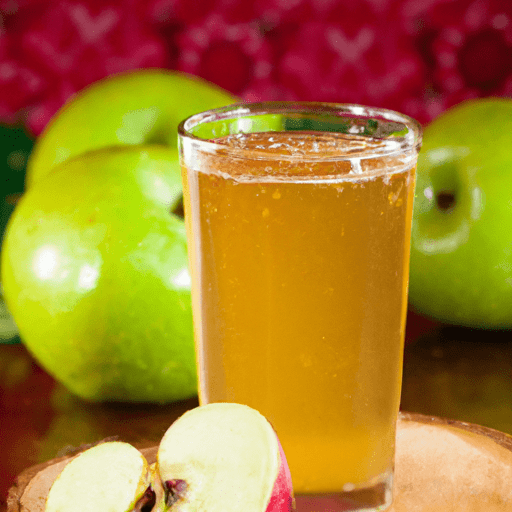The Delightful Apple Cider: A Fall Classic
As the crisp autumn breeze sets in, there’s nothing quite as comforting and heartwarming as a mug of freshly made apple cider. This beloved seasonal beverage has become a staple during the fall months, enticing our taste buds with its unique flavors and soothing aroma. In this blog post, we’ll dive into the delicious world of apple cider, exploring its taste, common culinary uses, nutritional value, and fascinating history.
The Taste of Autumn in a Glass
Apple cider is a beverage crafted from the juice of ripe apples. One sip instantly transports you to an orchard, with its remarkable blend of sweet and tart flavors. Served both hot and cold, apple cider offers a refreshing taste that can be enjoyed by people of all ages.
The aroma of apple cider is equally enticing, evoking memories of seasonal spices like cinnamon, nutmeg, and cloves. This beverage not only delights our taste buds but also fills the air with a heartwarming fragrance, making it an ideal companion for cozy evenings indoors or gatherings with loved ones.
Culinary Uses Beyond the Mug
While apple cider is a delight to enjoy on its own, it also shines as a versatile ingredient in the culinary world. Its natural sweetness and distinct flavor profile make it a perfect addition to a wide range of dishes, both sweet and savory.
One classic application of apple cider is using it as a glaze for roasted meats such as pork or chicken. The cider’s natural sugars caramelize beautifully, creating a mouthwatering glaze that adds a touch of autumnal deliciousness to the dish.
For those with a sweet tooth, apple cider can be reduced to a luscious syrup and drizzled over pancakes, waffles, or even ice cream. The syrup effortlessly captures the essence of the cider, enhancing the flavors of your favorite sweet treats.
Nutritional Value
Apart from its delectable taste and culinary versatility, apple cider also offers some notable nutritional value. Though the specific values may vary depending on the brand, homemade apple cider is generally a good source of vitamins, minerals, and antioxidants.
Apples, the primary ingredient in cider, are rich in vitamin C, which plays a crucial role in supporting the immune system. Furthermore, apples contain soluble fiber, which aids in digestion and supports heart health. When enjoyed in moderation, apple cider can be a wholesome beverage choice.
A Historical Sip
Apple cider has a deep-rooted history, dating back centuries. It is believed to have originated in ancient Greece and Rome, where the art of pressing apples to make cider began. Over time, cider-making techniques spread across Europe, particularly to cider-loving regions like France, Spain, and England.
During colonial times in America, apple orchards proliferated, leading to increasing popularity in cider production. In fact, cider was widely enjoyed in the United States until the 19th century when the temperance movement and the rise of beer and spirits consumption led to a decline in cider’s popularity. However, the recent revival of interest in artisanal and craft beverages has brought apple cider back into the limelight.
Raise Your Glass to Apple Cider
Whether you sip it from a mug, use it as an ingredient in your favorite recipe, or indulge in its historical significance, apple cider is a true fall classic that continues to captivate us with its enticing flavors and aromas. So, next time you find yourself in the midst of autumn, be sure to raise your glass and savor the delightful essence of this beloved beverage. Cheers to apple cider!
Sure! Here are some interesting facts about apple cider:
Origin: Apple cider is believed to have originated in ancient Rome, where it was known as “mulsum” and was a mixture of fermented apple juice with honey and spices. The tradition of making apple cider spread throughout Europe and eventually to North America.
Production: Apple cider is a beverage made by pressing fresh apples to extract the juice. The juice is then usually strained and sometimes pasteurized to kill any bacteria or yeast, making it safe to drink. It is often consumed fresh, although it can also be fermented to produce hard cider or further processed to make apple cider vinegar.
Common uses: Apple cider is commonly enjoyed as a refreshing non-alcoholic beverage, especially during the autumn season. It is often served warm and spiced with cinnamon, nutmeg, or other seasonal spices. Apple cider can also be used as an ingredient in recipes for desserts, marinades, sauces, and dressings.
Nutritional benefits: Apple cider is a good source of vitamin C and contains antioxidants, which are beneficial for health. It also provides some dietary fiber and minerals like potassium. However, it is important to note that the nutritional content can vary depending on the specific production methods and whether any additional ingredients, such as sweeteners, are added.
Unique properties: Apple cider can have a range of flavors depending on the variety of apples used, as well as the climate and soil conditions in which they are grown. Some ciders may taste sweet and fruity, while others can be tart or have a complex flavor profile. Additionally, the process of fermentation can add a natural effervescence to certain types of apple cider.
Historical significance: In the early days of America, apple cider was a staple beverage and was often safer to drink than water due to the lack of proper sanitation. It played an important role in colonial life, and many regions had their own unique cider apple cultivars. However, the popularity of apple cider declined during the 20th century, only to make a comeback in recent years as artisanal and craft ciders gained popularity.
Remember to always check the label when purchasing apple cider to ensure it is made from pure apple juice without any added preservatives or sweeteners.




Use the share button below if you liked it.
It makes me smile, when I see it.